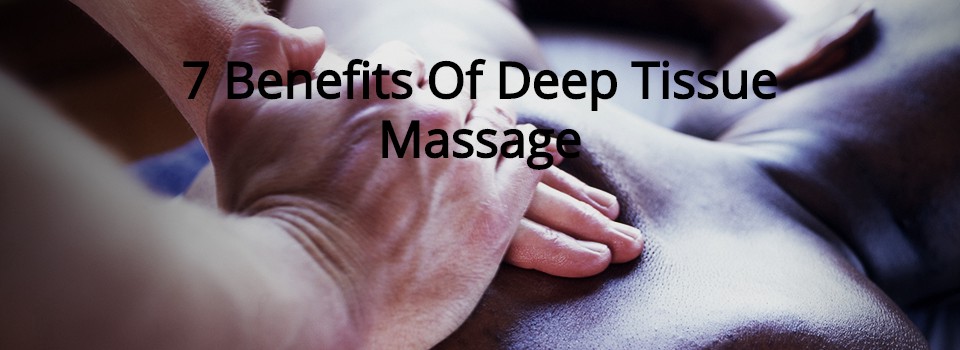 7 Benefits Of Deep Tissue Massage
7 Benefits Of Deep Tissue Massage
If you are an athlete with a high daily demand on your body or you are recovering from an injury or illness, it is likely that the benefits of deep tissue massage have some favours to offer you; Massages have been used for thousands of years around the world to reduce physical and psychological stress. And today, research continues to show that, whether used alone or in combination with other treatments, massage therapy is an effective way to help treat common conditions such as arthritis, anxiety and chronic low back pain.
The main objective of deep tissue massage is to reduce pain and discomfort while improving the body?s ability to heal itself. Swedish and deep tissue massage are not only relaxing, they also help to ?lengthen and release the muscles? that often feel tight and get stuck in uncomfortable attachment patterns.
Let?s explore what exactly is the deep tissue massage and all the ways it can benefit your body and mind.
Benefits of Deep Tissue Massage
- Treat Chronic Back Pain
A study that compared the effectiveness of two different types of massage to treat chronic back pain, therapeutic massage versus the benefits of deep tissue massage (TMD), found that DTM treatment over the course of 10 days produced significantly better improvements in the pain compared to therapeutic massage.
In this particular study, the therapeutic massage included beating and friction techniques, while DTM used oblique pressure and a combination of stretching and cross-strokes of fibre. All sessions lasted 30 minutes and were performed daily and all participants received no other treatment during the study. After 10 days, participants treated with TMD reported significant improvements in pain (low back pain in this case) compared to those treated with therapeutic massage, modified back pain disability index scores, the disability scale of Quebec back pain and the visual analogue Scales.
Other studies have shown similar findings. One study even found that DTM treatment alone had such a positive effect in reducing pain in patients with chronic symptoms compared to the massage analgesics and NSAIDs used as a whole.
2. Help Reduce High Blood Pressure
One study found that the benefits of deep tissue massage had positive effects on systolic, diastolic and mean blood pressure readings in adults with symptoms of pain and high blood pressure.
The study involved 263 volunteers with an average age of 48.5. The global muscle spasm/muscle distension was described as moderate or severe for each patient before the treatments, which consisted of a massage lasting 45?60 minutes. The results showed a reduction in mean systolic pressure of 10.4 mm/Hg, a reduction in diastolic pressure of 5.3 mm/Hg, a reduction in mean arterial pressure of 7.0 mm/Hg and a reduction in The average heart rate of 10.8 beats per minute after the massage treatment.
3. Reduce Stress, Anxiety And Muscle Tension
Inflammation caused by chronic stress and muscle tension can worsen overall health, prolong recovery time, reduce immune function and cardiovascular problems, such as high blood pressure. Studies have found that massage therapy can help reduce cortisol levels and even increase the production of the hormone oxytocin, which relaxes the body and has calming effects.
Oxytocin is the main hormone responsible for maintaining social bonds in humans and increasing the motivation for cooperative behaviours, so it is often called ?hug hormone? and is known to be released during hugs, birth, social bond, and Contact.
Several mechanisms for the natural effects of stress relief with the benefits of deep tissue massage include its ability to dilate blood vessels and also less activity of the limbic system (including the hypothalamus), which is responsible for autonomic regulation of the nervous system and the secretion of cortisol. It has been shown that massage improves relaxation by increasing the activity of the parasympathetic nervous system, as measured by heart rate, blood pressure and variability of heart rate.
4. Break The Tissue Of The Scar
The benefits of deep tissue massage are often used after injuries to help break up newly formed scar tissue that can hinder recovery and produce stiffness. It has been shown that massage helps reduce inflammation and muscle spasms by stimulating blood flow, relaxing the muscles to allow more oxygen and also helps reduce the automatic response to the stress of the nervous system.
After an injury, and especially if it is also a very stressful time, inflammation can prevent adequate blood flow from reaching damaged tissue and can cut off vital nutrients and oxygen. This can cause toxins to accumulate around the damaged tissue, which only increases swelling and pain. Some studies have found that even self-administered massage can help reduce the pain associated with plantar fasciitis and other injuries.
5. Improve Athletic Recovery And Performance
The research reported the findings of a positive trend for the benefits of deep tissue massage, in terms of improving recovery and athletic performance. The type of deep tissue massage most beneficial to athletes is considered as ?sports massage,? which is commonly performed before sporting events to help warm the body and prevent injury or immediately afterwards to improve recovery.
The report showed that the science of sports massage has become a growing interest in athletes, athletic trainers, coaches and sports physiologists. Studies show that deep tissue massages can help improve lactate clearance, delay the onset of muscle pain, muscle fatigue, injury prevention and treatment of injuries.
The researchers also point out that there are psychological benefits for athletes who receive massages, which other research shows may include improved focus and confidence. Although more research is still needed on a long-term scale, both tissue healing and the psychological effects of massage are areas that seem promising for both professional and recreational athletes.
6. Can Help With The Pain Of Delivery And Delivery
Many pregnant women now turn to alternative/complementary medications to help control labour pain and support a natural delivery process such as the Bradley Method. In fact, surveys show that the most common alternative therapies recommended during pregnancy are massage therapy, acupuncture and chiropractic therapies.
Some research has shown that massage therapy can be effective during pregnancy due to its lowering effects of anxiety, and women who receive massage before and during labour tend to experience depression, anxiety and pain in the legs and back. The results of a study found that women who received massages before and during labour had significantly less pain, and his works were on average three short hours and required less need for medication.
Because cortisol levels decrease after the massage and blood flow is improved, pregnant women are also better protected against the excessive fetal activity and the risk of premature delivery.
7. Reduces The Symptoms Of Arthritis
According to some specialised institutions, massage is often used to relieve the common symptoms of many types of arthritis, such as chronic joint pain, stiffness, anxiety, limited range of movement in the joints and problems sleeping. Firm massages can be used daily for natural relief, whether performed by a professional or by the patient himself.
Research shows that firmer massages with more pressure can result in a significant reduction in arthritis pain compared to lighter massages. Lighter massage tends to be exciting (not relaxing) because often the heart rate increases. However, with moderate pressure, the heart rate is usually low, and this stimulates relaxation and reduced tension.


